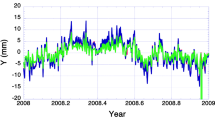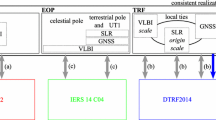Abstract
DORIS (Détermination d’Orbite et Radiopositionnement Intégrés par Satellite) is a system used for precise orbit determination (POD) and ground-station positioning. It has been implemented on-board various satellites: the SPOT (Système pour l’Observation de la Terre) remote sensing satellites SPOT-2, SPOT-3, SPOT-4, SPOT-5, TOPEX/Poseidon and more recently on its successors Jason-1 and ENVISAT. DORIS is also a terrestrial positioning system that has found many applications in geophysics and geodesy; in particular, it contributes to the realization of the International Terrestrial Reference Frame, ITRF2000 and the forthcoming ITRF2005. Although not its primary objective, DORIS can bring information on Earth orientation monitoring, mainly polar motion and length of day (LOD) variations that complement other astrogeodetic techniques. In this paper, we have analyzed various recent polar motion solutions derived from independent analysis centers using different software packages and applying various analysis strategies. Comparisons of these solutions to the International Earth Rotation and Reference Systems Service (IERS) C04 solution are performed. Depending on the solutions, the accuracy of DORIS polar components are in the range of 0.5–1 mas corresponding to a few centimeters on the Earth’s surface. This is approximately ten times larger than results derived from GPS, which are typically 0.06 mas in both components. This does not allow DORIS results to be taken into account in the IERS–EOP combinations. A gain in the precision could come from technical improvements to the DORIS system, in addition to improvement of the orbit, tropospheric, ionospheric and Earth gravity field modeling.
Similar content being viewed by others
References
Altamimi Z, Boucher C (2002) Multi technique combination of time series of station positions and Earth orientation parameters in IERS Technical Note 30. In: Richter B, Schwegmann W, Dick W (eds) Verlag des Bundesamsts für Kartographie und Geodäsie, vol. 235, pp 102–106. ISBN 3-89888-877-0
Altamimi Z, Sillard P, Boucher C (2002) ITRF2000: A New Release of the International Terrestrial Reference Frame for Earth Science Applications. J Geophys Res 107(B10): ETG 2-1, 2214. DOI 10.1029/2001JB000561
Altamimi Z, Boucher C, Gambis D (2005) Long-term stability of the terrestrial reference frame. Adv Space Res 36(3):342–349 DOI 10.1016/j.asr.2005.03.068
Barlier F (2005) The DORIS system, A fully operational tracking system to get orbit determination at centimeter accuracy in support of Earth observations. C.R. Geoscience 337(14):1223–1224 DOI 10.1016/j.crte.2005.07.007
Biancale R, Balmino G, Lemoine JM, Marty JCh, Moynot B, Barlier F, Exertier P, Laurain O, Gegout P, Schwintzer P, Reigber C, Bode A, König R, Massmann FH, Raimondo JC, Schmidt R, Zhu S (2000) A new global Earth’s gravity field model from satellite orbit perturbations: GRIM5 S1. Geophys Res Lett 27(22):3611–3614
Blackman RB, Tukey JW (1958) The measurement of power spectra from the point of view of communication engineering. Dover, New York, 190 p
Crétaux J-F, Soudarin L, Cazenave A, Bouillé F (1998) tectonic plate motions and crustal deformations from the DORIS space system. J Geophys Res, Solid Earth 103(B12):30167–30181
Crétaux J-F, Soudarin L, Earth rotation parameters time series derived from DORIS technieuq, subm to J Geod, DORIS Special Issue
Dorrer M, Laborde B, Deschamps P (1991) DORIS (Doppler orbitography and radiopositioning integrated from space), System assessment results with DORIS on SPOT-2. Acta Astronaut 25(8–9):497–504
Gambis D (1996). Monitoring Earth Rotation using various techniques, current results and future prospects. In: Wytrzyszczak, Lieske, Feldman (eds). Celestial mechanics and dynamical astronomy. vol 66(1). Kluwer, Dordrecht, 592 p, ISBN: 0792345746
Gambis D (2002) Allan variance analysis applied to Earth orientation analysis. Adv Space Res 30(2):207–212
Gambis D (2004) Monitoring Earth orientation using space-geodetic techniques, state-of-the-art and prospective. J Geod 78(4–5):295–303
Gambis D, Carlucci T (2002) Determination of the Earth Polar Motion by Doris technique, 2002. IDS Workshop, Biarritz, pdf paper, http://ids.cls.fr/html/report/ids_workshop_2002/programme.html
Gray JE, Allan DW (1974) In: Proceedings of the 28th annual symposium on frequency control, pp 243–246
Jayles C, Costes M (2004) Ten centimeters orbits in real-time on-board of a satellite: DORIS- DIODE current status. Acta Astronaut 54(5):315–323
Kuzin SP, Tatevian SK (2005) Determination of seasonal geocenter variations from DORIS, GPS and SLR data. In: Capitaine N (ed.) Proceedings Journées Systèmes de Référence spatio-temporels “Earth dynamics and reference systems: five years after adoption of the IAU 2000 Resolutions” (in press)
Lefebvre M, Cazenave A, Escudier P, Crétaux JF, Soudarin L, Valette JJ (1996) Space tracking system improves accuracy of geodetic measurements. EOS Trans 77:25, 28–29
Lemoine FG, Smith DE, Kunz L, Smith R, Pavlis EC, Pavlis NK, Chinn DS, Torrence MH, Williamson RG, Cox CM, Rachlin KE, Wang YM, Kenyon SC, Salman R, Trimmer R, Rapp RH, Nerem RS (1997) EGM6 Earth gravity model, gravity, geoid and marine geodesy. In: Segawa J, Fujimoto H, Okubo S (eds) 17th International Association of Geodesy Symposia, pp 461–469
Lemoine JM, Capdeville H (2006) Corrective model for Jason-1 DORIS Doppler data. J Geod (in press)
Lichten SM, Bar-Sever YE, Bertiger EI, Heflin M, Hurst K, Muellerschoen RJ, Wu SC, Yunck TP, Zumberge JF (1995) GIPSY-OASIS II: a high precision GPS data processing system and general orbit analysis tool, Technology 2006. NASA Technology Transfer Conference, Chicago
Louet J (2001) The ENVISAT mission and system. ESA Bull 106:11–25
Luthcke S, Zelensky N, Rowland DD (2003) The 1-cm orbit, Jason-1 precise orbit determination using GPS, SLR, DORIS and altimeter data, Specia1 Issue, Jason-1, Calibration/Validation, Marine Geod 26(3,4):399–421
McCarthy DD, Luzum BJ (1991) Combination of Precise Observations of the Orientation of the Earth. Bull Géod ISSN 0007-4632), 65(22):22–27
Ménard Y, Fu LL, Escudier P (2003) The Jason-1 mission. Marine Geod 26(3,4):131–146
Nouël F, Berthias JP, Deleuze M (1994) Precise Centre Nationa1 d’Etudes Spatiales orbits for TOPEX/Poseidon, is 2-cm still a challenge. J Geophys Res Oceans 99(C12):24405–24419
Reigber C, Schmidt R, Flechtner F, Konig R, Meyer U, Neumayer KH, Schwintzer P, Zhu SY (2005) An Earth gravity field model complete to degree and order 150 from GRACE: EIGEN-GRACE02S. J Geodyn 39(1):1–10
Rummel R, Rothacher M, Beutler G (2005) Integrated Global geodetic System (IGGOS), Science rationale. J Geodyn 40(4,5):357–362
Soudarin L, Crétaux JF, Cazenave A (1999) Vertical crustal motions from the DORIS space-geodesy system. Geophys Res Lett 26(9):1207–1210
Tapley BD, Bettadpur S, Watkins M, Reigber C (2004) The gravity recovery and climate experiment, Mission overview and early results. Geophys Res Lett 31(9):art L09607
Tavernier G, Granier J-P, Jayles C (2003) The current evolutions of the DORIS system. Adv Space Res 31(8):1947–1952
Tavernier G, Soudarin L, Larson K, Noll C, Ries J, Willis P (2002) Current status of the DORIS pilot experiment and the future International DORIS Service. Adv Space Res 30(2):151–156 DOI 10.1016/s0273-1177(02)00279-x
Tavernier G, Fagard H, Feissel-Vernier M (2005) The International DORIS Service (IDS). Adv Space Res 36(3):333–341 DOI 10.1016/j.asr.2005.03.103
Vondrák J (1969) A contribution to the problem of smoothing observational data. Bull Astron Inst Czechosl 20:349–355
Vondrák J (1977) Problem of smoothing observational data II. Bull Astron Inst Czechosl 28:84–89
Vondrák J, Čepek A (2000) Combined smoothing method and its use in combining Earth orientation parameters measured by space techniques. Astron Astrophys Suppl Ser 147:347–359
Vondrák J, Gambis D (2000) Accuracy of Earth orientation parameters obtained by different techniques in different frequency windows. In: Soffel M, Capitaine N (eds) Journées 1999 Systèmes de référence spatio-temporels and IX Lohrmann Colloqium, Observatoire de Paris, pp 206–213
Willis P, Heflin M (2004) External validation of the GRACE GGM01C gravity field using GPS and DORIS positioning results Geophys Res Lett 31(13):art. L13616. DOI 10.1029/2004GL02003
Willis P, Ries J (2005) Defining a core network for Jason-1 Precise Orbit Determination. J Geod 79(6,7):370–378 DOI 10.1007/s00190-005-0475-9
Willis P, Bar-Sever Y, Tavernier G (2005a) DORIS as a potential part of a global geodetic observing system. J Geodyn 40(4,5):494–501 DOI 10.1016/j.jog.2005.06.011
Willis P, Boucher C, Fagard H, Altamimi Z (2005b) Geodetic applications of the DORIS system at the French Institut Géographique National. CR Geoscience 337(7):653–662 DOI 10.1016/j.crte.2005.03.002
Willis P, Berthias JP, Bar-Sever YE (2006) Systematic errors in the Z-geocenter derived using satellite tracking data, A case study from SPOT-4 DORIS data in 1998. J Geod 79(10,11):567–572 DOI 10.1079/s00190-005-0013-9
Willis P, Haines B, Berthias JP, Sengenes P, le Mouel JL (2004) Behavior of the DORIS/Jason oscillator over the South Atlantic Anomaly. CR Geoscience 336(9):839–846 DOI 10.1016/j.crte.2004.01.004
Willis P, Jayles C, B-S Ye Doris (2006) From orbit determination for altimeter missions to geodesy, CR Geoscience (in Special Issue Earth Observation from Space). DOI 10.1016/j.crte.2005.11.013 (in press)
Author information
Authors and Affiliations
Corresponding author
Rights and permissions
About this article
Cite this article
Gambis, D. DORIS and the Determination of the Earth’s Polar Motion. J Geodesy 80, 649–656 (2006). https://doi.org/10.1007/s00190-006-0043-y
Received:
Accepted:
Published:
Issue Date:
DOI: https://doi.org/10.1007/s00190-006-0043-y




